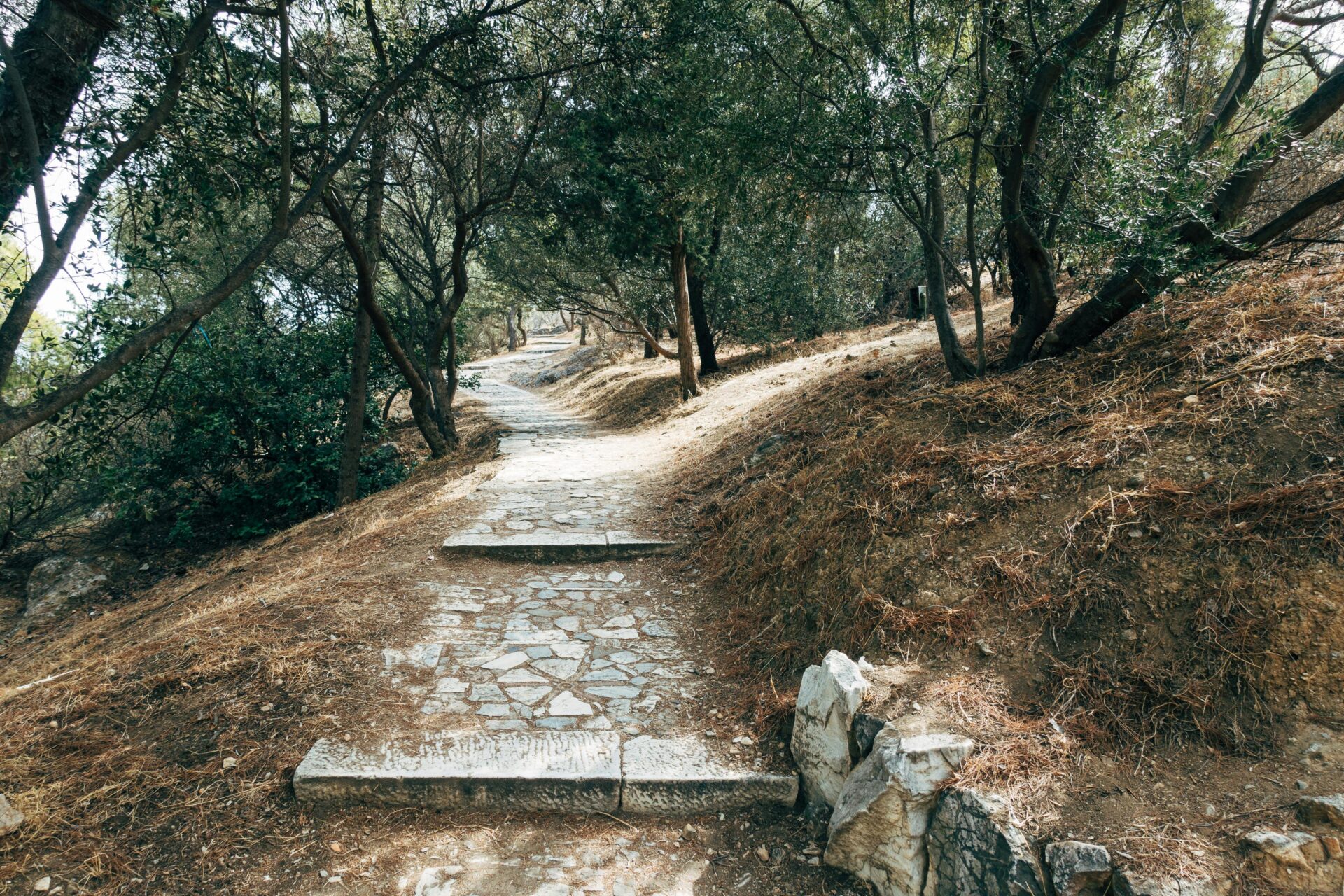As the sun slipped behind the mountains, I stood at the top of Lycabettus Hill, one of Athens’ highest points. The city below began to sparkle with golden lights, and the Acropolis glowed softly as daylight faded.
Watching Athens come alive at dusk from this incredible viewpoint felt romantic in a way I still can’t quite put into words.
It’s the little things that make it memorable—the cool breeze brushing past, the distant hum of the city, and those sweeping 360-degree views all the way to the sea. Couples and friends gathered around, soaking up the peace, often clutching a coffee or something sweet.
This is where the real heart of Athens shows itself, not just as a city of ruins and museums, but as a living place full of magic when night falls.

If you’re planning a romantic date or just want to see Athens in a new light, you really can’t miss Lycabettus at dusk. Locals and visitors flock here for a reason—it’s almost impossible not to fall for the city as it transforms in the evening.
Arriving at Lycabettus Hill: Setting the Scene
Twilight gives Athens a special kind of buzz. As I made my way to Lycabettus Hill, my excitement grew with every step, knowing a breathtaking view was waiting up top.
How to Get to Lycabettus Hill
Getting to Lycabettus Hill is simple, and honestly, it’s part of the fun. The hill rises steeply at the heart of Athens, its slopes visible from all over town.
Every year, loads of Athenians and travelers climb up for those panoramic views.
I started near Kolonaki, a lively district packed with shops and cafes. Most people either walk, grab a taxi, or hop on the funicular.
The funicular leaves from Aristippou and Ploutarchou streets and makes the climb easy, especially if you’re not in the mood for steep walks. But if you’re up for it, the winding path cuts through pine trees and feels peaceful in the evening.
If you want more of a local experience, try walking up through side streets and stone stairs. You’ll catch glimpses of charming courtyards and bits of city life you’d never notice otherwise.
It helps to check a map first—some paths are tricky to spot after dark.

Public Transportation Tips
Athens’ public transportation makes visiting Lycabettus Hill a breeze. I took the Metro to Evangelismos Station, the closest stop to the hill.
From there, it’s a 15-20 minute walk to the base or the funicular.
Buses stop nearby too, but the metro’s usually faster, especially during rush hour. If you’re staying out late, double-check the last train and bus times—Athens’ public transport doesn’t always run late.
Taxis are easy and affordable, especially if you’re with friends or just want a hassle-free ride. I used a ride-share app for the trip back and had no trouble getting picked up near the base, even after dark.
What to Bring for a Comfortable Evening
Comfort makes a huge difference on Lycabettus Hill at dusk. I wore sturdy boots since the rocky paths can get uneven or slick.
Even the paved spots felt a bit tricky in flimsy shoes.
I brought a light jacket because it cools off quickly once the sun sets—Athens’ warm days don’t last forever. A small flashlight or a phone with plenty of battery helped me find my way on dim paths.
A water bottle was a must after the climb. If you’re planning to stay a while, a small picnic and blanket make it all the more relaxing and romantic.
I also packed my camera; the changing light over the Parthenon and the city below was something I didn’t want to forget.
The Dusk Experience: Watching Athens Light Up
Standing atop Lycabettus Hill at dusk, I took in the changing sky, the gentle air, and the first city lights flickering on. This moment creates a vibe where ancient history, natural beauty, and the pulse of Athens all blend together.
Golden Hour Views Over Athens
Right before sunset, during the golden hour, Lycabettus Hill glows with warm, soft light. Sunbeams stretch across rooftops, monuments, and ancient ruins, bathing everything in gentle light.

The Acropolis, perched on its own hill, stands out against the skyline, glowing in golden tones that make every stone pop.
As the sun dipped lower, the whole city seemed to pause. Couples and friends gathered at the edge, quietly taking in the view.
The sky above Athens shifted from orange to deep pinks and soft purples.
It’s no wonder people rave about coming up here at this hour. The mood feels peaceful and romantic, a break from the busy streets below.
Seeing landmarks like the Acropolis and the distant hills reminded me just how much history and culture this city holds.

The Magic of Twilight: Transition From Day to Night
Twilight on Lycabettus Hill is when things get truly magical. As the last sunlight fades, Athens lights up, street by street.
Streetlights flicker on, tracing roads and squares in golden lines. The Parthenon glows softly, its grandeur highlighted against the darkening sky.
I stood with others, listening to laughter and quiet conversations as everyone waited for the city to transform. The cool breeze carried city sounds up the hill, blending the present with echoes of ancient Athens.
I felt the shift from day to night in a way that’s hard to describe—almost like you could reach out and touch it. Each monument seemed to wake up, shining against the deep blue sky.
The mix of light, shadow, and energy made dusk here feel truly special.
Capturing the Perfect Photo
As the sky deepened, I grabbed my camera and phone to try and capture the view. Golden hour and twilight are the best times for photos.
I looked for spots where I could fit both the Acropolis and the city lights into the frame.
The changing light made every shot different. Faces and buildings glowed with soft light at first, then sharp contrasts brought out the monuments as night settled in.
Propping my phone against a stone wall helped me avoid blurry shots.

Some photo tips I picked up:
- Arrive early: Grab a good spot before the crowds build up.
- Use panorama mode: The cityscape is just too wide to fit otherwise.
- Include people: Shots with friends or couples add a sense of scale and tell a better story.
Even with just a phone, I ended up with photos I’ll treasure. The mix of natural light and ancient landmarks made every shot feel special.
Romantic Touches: Planning the Perfect Evening
A little romance goes a long way on Lycabettus Hill. Honest conversations, small details, and a beautiful setting can turn an ordinary night into something you’ll both remember.
Ideal Timing for a Romantic Visit
Timing really matters here. I found that arriving an hour before sunset gave me time to settle in and take it all in without any rush.
The hill gets quieter as afternoon tourists leave, and the city glows as day fades.
Watching the sunset behind the Parthenon with my partner felt unforgettable. For special occasions, planning ahead helps you snag the best spot as Athens lights up.
Spring and early autumn evenings are mild and perfect for hand-in-hand strolls and cozy moments.

Here’s a quick table for the best times to arrive:
| Season | Best Time to Arrive |
|---|---|
| Spring | 6:30-7:00 pm |
| Summer | 7:30-8:00 pm |
| Autumn | 6:00-6:30 pm |
| Winter | 4:30-5:00 pm |
Finding a Quiet Spot for Two
Lycabettus can get crowded, especially on warm nights. For a bit of privacy, I wandered away from the main lookout and café.
Winding paths lined with pine trees and wildflowers offered quieter corners.
Sometimes, I found a bench or a shady spot near the chapel garden. I always made sure my partner felt comfortable before settling in.
Taking those less-traveled paths gives you privacy and a chance to enjoy some peace—just the two of you, away from the crowds.

Thoughtful Gestures and Gifts
To add a little magic, I brought a small gift—a single rose from a street vendor, or a handwritten note slipped into my partner’s hand.
Greek traditions tie romance to simple, thoughtful acts, like sharing a pastel (Greek dessert) or offering a pebble from the hill as a keepsake.
Kind gestures don’t have to be big or expensive. Planning a toast, sharing memories, or talking about future dreams can turn a normal night into a milestone.
I try not to rush things; the whole point is to enjoy each other’s company and let the evening unfold naturally under Athens’ glowing sky.
Athenian Flavors: Food and Drink Near Lycabettus
As the sun dipped behind the city, Lycabettus filled with the smell of fresh bread, sizzling gyros, and roasted nuts. It’s not just about the view—every sense gets in on the experience.
Best Cafés and Restaurants at the Summit
After the climb or the funicular ride, I found a few cozy cafés and the well-known Orizontes restaurant at the top. Orizontes serves Mediterranean dishes and offers sweeping city views—just right for a romantic dinner.
Their menu highlights fresh local ingredients, from simple salads to grilled fish.
For something lighter, I stopped at a small café with coffee, pastries, and traditional Greek bread. Tables spilled onto the terrace, and I sipped a frappe while the city twinkled below.
At dusk, the vibe was relaxed and friendly, not too crowded.

Local Treats to Try: Gyros, Bread, and Nuts
Street vendors near the base and local shops along the climb tempted me with snacks. I grabbed a classic pita gyros, packed with seasoned meat, tomato, onion, and creamy tzatziki.
The smell alone made my mouth water.
Many stands sell koulouri, a sesame-crusted bread ring that’s soft inside and crunchy outside. If you want something sweet or nutty, roasted almonds and walnuts are popular, usually sold in little paper cones.
Greek nuts are known for their flavor and health benefits, so they make a smart snack for the walk.

Wine, Water, and Evening Picnics
Bringing a picnic up Lycabettus is a tradition I absolutely recommend. I packed some fresh bread, local cheese, and a bottle of Greek white wine from a nearby shop.
Drinking wine up here, watching the city turn gold and pink, felt both dreamy and simple.
If you’re skipping alcohol, the spring water from a few fountains tastes crisp after the climb. It’s perfect for staying hydrated on warm Athens evenings.
If you want something different, try a local herbal tea as dusk settles in.
Picnicking lets you savor Athens at your own pace and opens the door for relaxed, heartfelt conversations.
Cultural Insights and Local Legends
Standing on Lycabettus Hill at dusk, I realized the view is more than just stunning—it’s layered with stories. This spot is a crossroads of history, myth, famous Athenian heroes, and living Greek culture.
Lycabettus in Greek Mythology
Lycabettus Hill isn’t just another spot on the map. Legend says Athena herself made it.
Apparently, Athena lugged a massive rock to help build the Acropolis. But then, the rock slipped from her hands and landed where Lycabettus stands now.
People back in ancient times believed this story. That’s how they explained why Lycabettus rises so sharply above Athens.
Since Athena ties herself to the hill, the place feels sacred. I’ll admit, standing there in the soft evening light, I felt a weirdly strong connection to those old myths.
Other sites around Athens—Delphi, Olympia, you name it—have their own links to the gods. Still, Lycabettus really stands out as Athena’s mark on the city.

Legends of Athens: Leonidas, Cimon, and More
Generations of legends have wandered around Lycabettus. In Athens, you just can’t separate the land from names like Leonidas, who led the Spartans at Thermopylae, or Cimon, the statesman everyone admired for his victories and generosity.
Sure, Leonidas belongs more to Sparta, but Athenians still respect his courage. Cimon wandered these hills, meeting with others and shaping Athenian democracy.
Just below Lycabettus, big names like Themistocles (the guy who won Salamis), Glaucon, and Lycon debated politics and philosophy. Stories from the Persian Wars—defending against Xerxes, winning at Salamis and Plataea—give these stones even more meaning.
Even poets like Simonides of Ceos wandered this world, their verses probably echoing off the slopes. Sometimes, when I walk these paths, I swear I can almost hear their voices.
Festivals and Modern Celebrations
Modern Athens still celebrates Lycabettus’s place in its culture. Every summer, the open-air Lycabettus Theater fills with music festivals, concerts, and plays that nod to ancient myths and heroes.
These events often honor Athenian history. You’ll catch references to the Olympic tradition and local games like Nemean and Isthmian competitions.

Locals love climbing the hill for religious festivals tied to Saint George. His small chapel sits right at the top.
On those festival nights, the city feels electric. Old rituals blend with young voices and the pulse of Greek music.
I remember climbing at dusk before a festival. That timing let me catch both the sweeping view and the lively spirit of Athens lighting up below.
Visitors come from Santorini, other islands, and even towns like Hermione. Everyone joins in the celebrations, sharing the history and the simple joy under the city’s glow.

